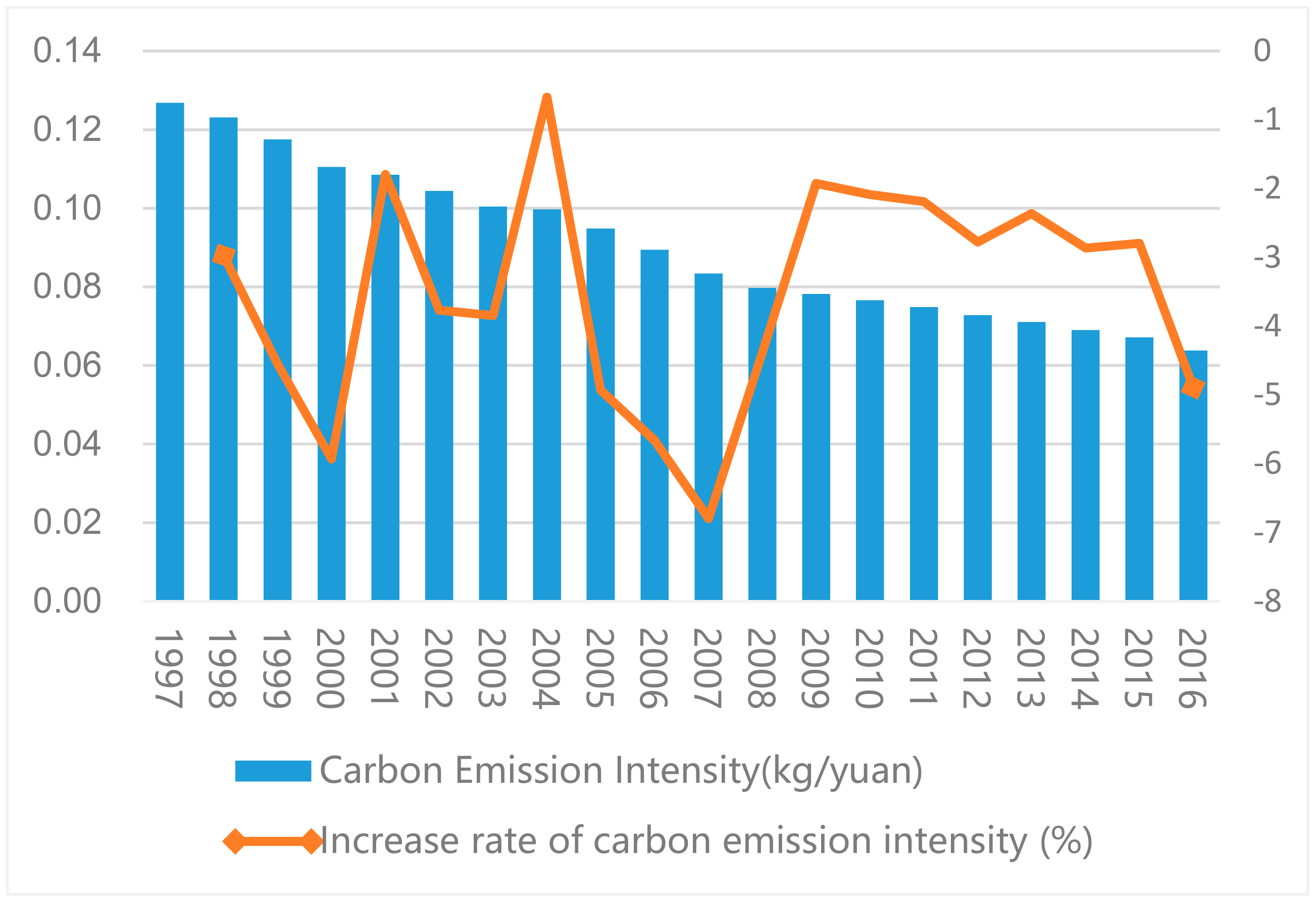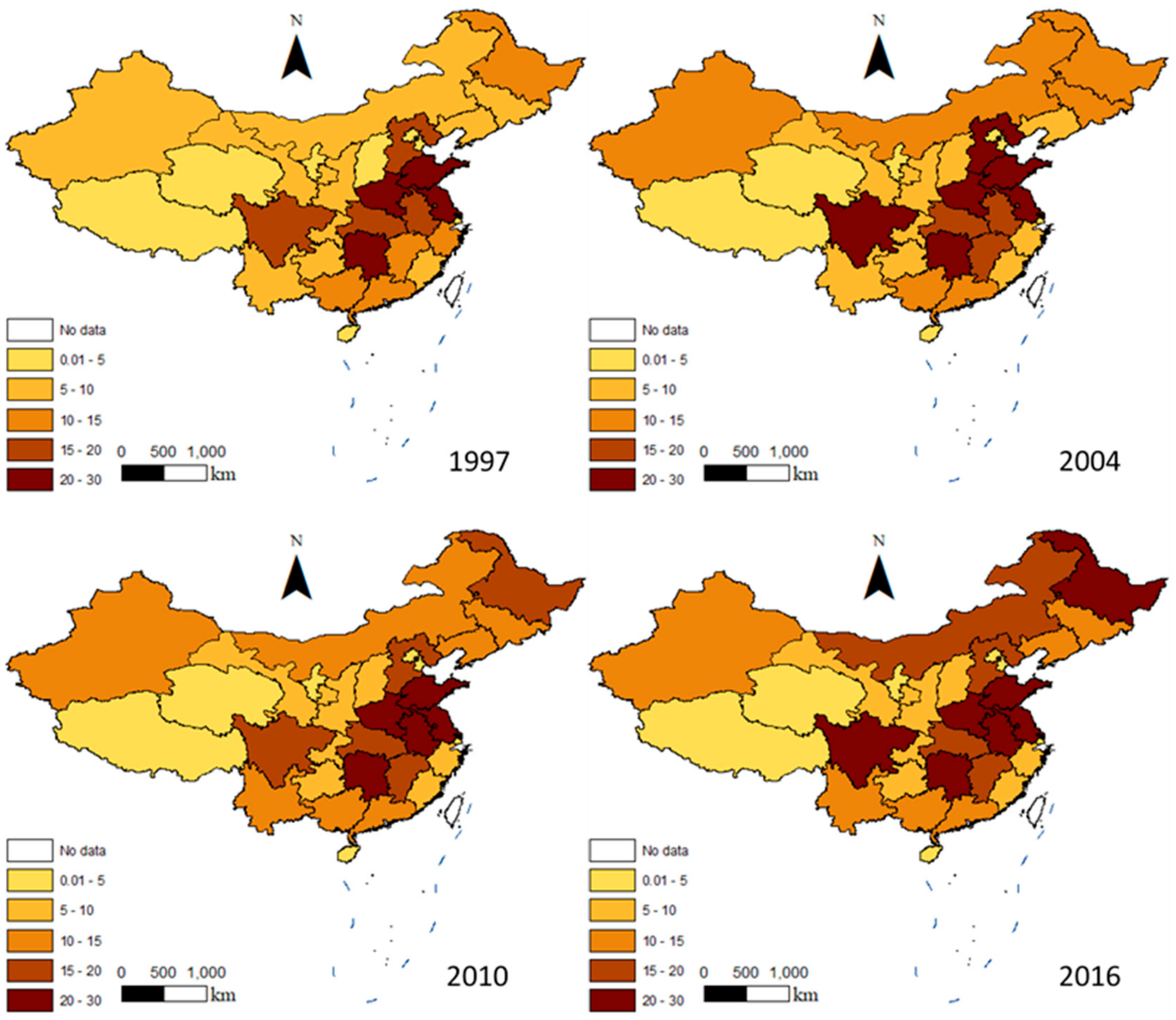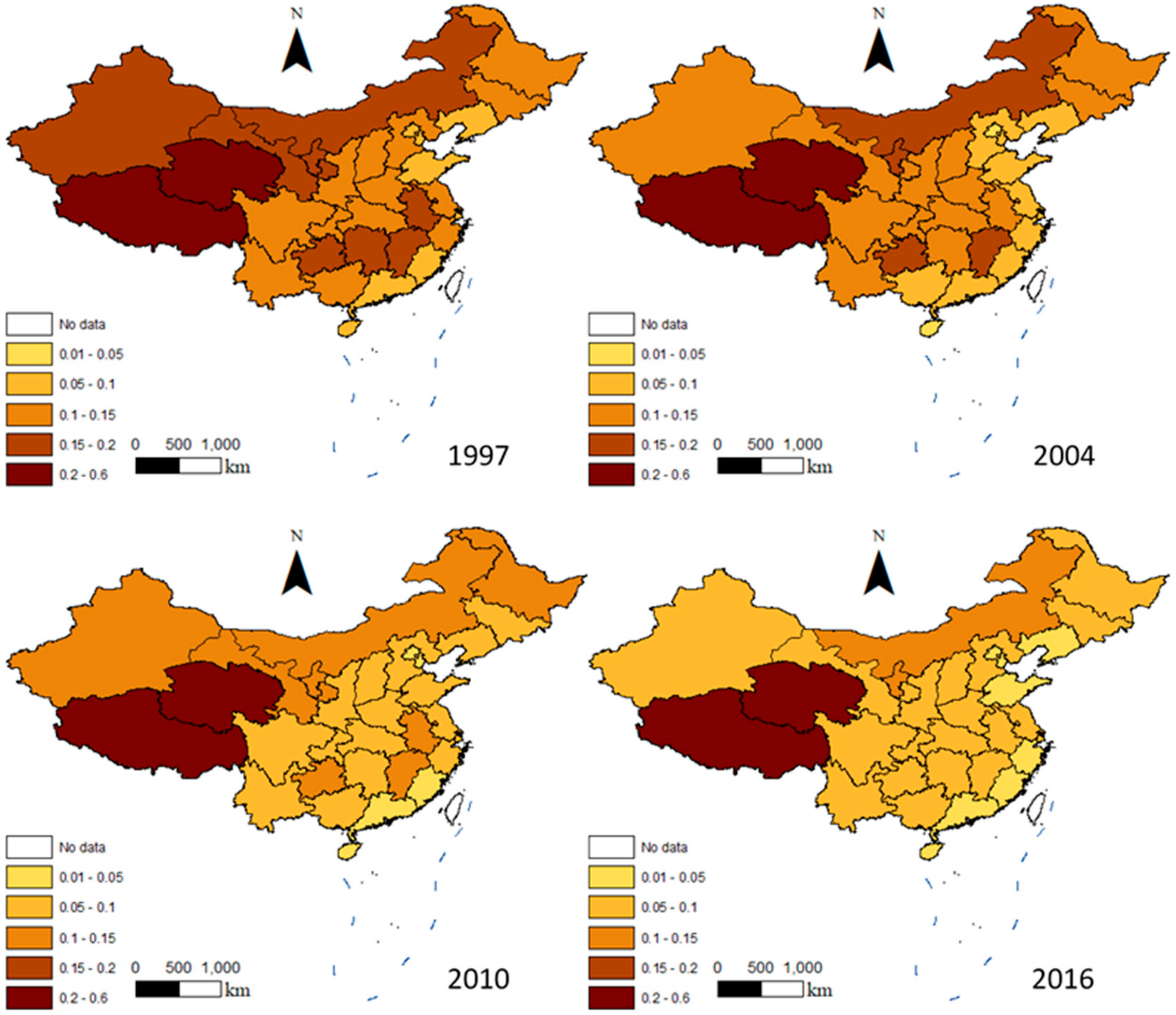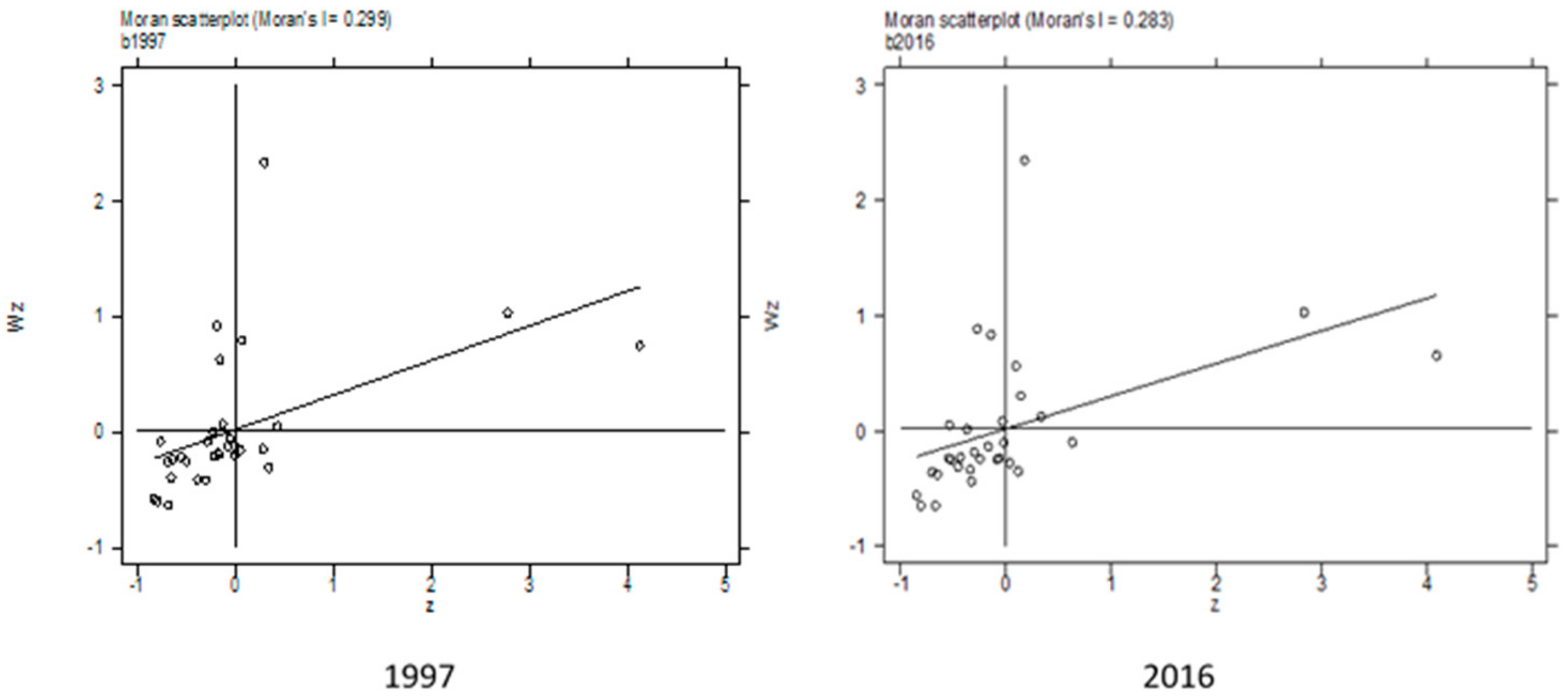Assessment of Agricultural Carbon Emissions and Their Spatiotemporal Changes in China, 1997–2016
Abstract
1. Introduction
2. Materials and Methods
2.1. Estimation of Agricultural Carbon Emissions (ACEs)
2.2. Sample Selection and Data Sources
2.3. Sources of ACEs
2.3.1. Carbon Emissions from Agricultural Materials
2.3.2. Carbon Emissions from Rice Cultivation.
2.3.3. N2O Emissions Caused by Damage to Soil Surface during Crop Planting
2.3.4. Carbon Emissions from Livestock and Poultry Farming
2.3.5. Carbon Emissions from Straw Burning
3. Results
3.1. Evolution of China’s ACEs
3.1.1. Evolutional Characteristics of China’s ACEs
3.1.2. Evolutional Characteristics of the Amount of ACEs by Source
3.2. Spatial Variation of China’s ACEs
3.2.1. Spatial Evolutional Characteristics of ACEs
3.2.2. Spatial Evolutional Characteristics of ACEs by Source
3.2.3. Analysis of the Spatial Correlation of China’s ACEs
4. Discussion
Author Contributions
Funding
Acknowledgments
Conflicts of Interest
References
- Angelakoglou, K.; Gaidajis, G. A review of methods contributing to the assessment of the environmental sustainability of industrial systems. J. Clean. Prod. 2015, 1, 1–23. [Google Scholar] [CrossRef]
- Xu, X.; Xu, Z.; Chen, L.; Li, C. How Does Industrial Waste Gas Emission Affect Health Care Expenditure in Different Regions of China: An Application of Bayesian Quantile Regression. Int. J. Environ. Res. Public Health 2019, 16, 2748. [Google Scholar] [CrossRef] [PubMed]
- Tian, Y.; Li, B.; Zhang, J.B. Research on spatial temporal characteristics and factor decomposition of agricultural carbon emission based on input angle–taking Hubei province for example. Res. Agric. Mod. 2011, 32, 752–755. (In Chinese) [Google Scholar]
- Bai, Y.; Deng, X.; Jiang, S.; Zhao, Z.; Miao, Y. Relationship between climate change and low-carbon agricultural production: A case study in Hebei Province, China. Ecol. Indic. 2019, 105, 438–447. [Google Scholar] [CrossRef]
- Gan, Y.; Liang, C.; Chai, Q.; Lemke, R.L.; Campbell, C.A.; Zentner, R.P. Improving farming practices reduces the carbon footprint of spring wheat production. Nat. Commun. 2014, 5, 5012. [Google Scholar] [CrossRef]
- Chamberlain, S.D.; Ingraffea, A.R.; Sparks, J.P. Sourcing methane and carbon dioxide emissions from a small city: Influence of natural gas leakage and combustion. Environ. Pollut. 2016, 218, 102–110. [Google Scholar] [CrossRef] [PubMed]
- De Araújo, M.S.M.; Silva, C.; de Campos, C.P. Land use change sector contribution to the carbon historical emissions and the Sustainability-Case study of the Brazilian Legal Amazon. Renew. Sustain. Energy Rev. 2009, 13, 696–702. [Google Scholar] [CrossRef]
- Ali, G.; Nitivattananon, V. Exercising multidisciplinary approach to assess interrelationship between energy use, carbon emission and land use change in a metropolitan city of Pakistan. Renew. Sustain. Energy Rev. 2012, 16, 775–786. [Google Scholar] [CrossRef]
- Balmford, A. The potential for land sparing to offset greenhouse gas emissions from agriculture. Nat. Clim. Chang. 2016, 6, 488–492. [Google Scholar] [CrossRef]
- Dong, F.; Zhang, S.; Long, R.; Zhang, X.; Sun, Z. Determinants of haze pollution: An analysis from the perspective of spatiotemporal heterogeneity. J. Clean. Prod. 2019, 222, 768–783. [Google Scholar] [CrossRef]
- Lal, R. Carbon emission from farm operations. Environ. Int. 2004, 30, 981–990. [Google Scholar] [CrossRef] [PubMed]
- Gomiero, T.; Paoletti, M.G.; Pimentel, D. Energy and environmental issues in organic and conventional agriculture. Crit. Rev. Plant Sci. 2008, 27, 239–254. [Google Scholar] [CrossRef]
- Mirza, F.M.; Kanwal, A. Energy consumption, carbon emissions and economic growth in Pakistan: Dynamic causality analysis. Renew. Sustain. Energy Rev. 2017, 72, 1233–1240. [Google Scholar] [CrossRef]
- Alshehry, A.S.; Belloumi, M. Energy consumption, carbon dioxide emissions and economic growth: The case of Saudi Arabia. Renew. Sustain. Energy Rev. 2015, 41, 237–247. [Google Scholar] [CrossRef]
- Eggoh, J.C.; Bangake, C.; Rault, C. Energy consumption and economic growth revisited in African countries. Energy Policy 2011, 39, 7408–7421. [Google Scholar] [CrossRef]
- Xu, X.; Chen, L. Projection of Long-Term Care Costs in China, 2020–2050, Based on the Bayesian Quantile Regression Method. Sustainability 2019, 11, 3530. [Google Scholar] [CrossRef]
- Gozgor, G.; Lau, C.K.M.; Lu, Z. Energy consumption and economic growth: New evidence from the OECD countries. Energy 2018, 153, 27–34. [Google Scholar] [CrossRef]
- Odhiambo, N.M. Energy consumption and economic growth nexus in Tanzania: An ARDL bounds testing approach. Energy Policy 2009, 37, 617–622. [Google Scholar] [CrossRef]
- Kragt, M.E.; Pannell, D.J.; Robertson, M.J.; Thamo, T. Assessing costs of soil carbon sequestration by crop-livestock farmers in Western Australia. Agric. Syst. 2012, 112, 27–37. [Google Scholar] [CrossRef]
- Burney, J.A.; Davis, S.J.; Lobell, D.B. Greenhouse gas mitigation by agricultural intensification. Proc. Natl. Acad. Sci. USA 2010, 107, 12052–12057. [Google Scholar] [CrossRef]
- Xu, X.; Chen, L. Influencing factors of disability among the elderly in China, 2003-2016: Application of Bayesian quantile regression. J. Med. Econ. 2019, 22, 605–611. [Google Scholar] [CrossRef] [PubMed]
- Bracmort, K. Nitrous oxide from agricultural sources: Potential role in greenhouse gas emission reduction and ozone recover. Congr. Res. Serv. 2010, 1, 1–9. [Google Scholar]
- West, T.O.; Marland, G. A synthesis of carbon sequestration, carbon emissions, and net carbon flux in agriculture: Comparing tillage practices in the United States. Agric. Ecosyst. Environ. 2002, 91, 217–232. [Google Scholar] [CrossRef]
- Johnson, J.M.F. Agricultural opportunities to mitigate greenhouse gas emissions. Environ. Pollut. 2007, 150, 107–124. [Google Scholar] [CrossRef]
- Qiu-cheng, T.A.N. Greenhouse Gas Emission in China’s Agriculture: Situation and Challenge. China Popul. Resour. Environ. 2011, 29, 69–75. (In Chinese) [Google Scholar]
- Yigen, W.; Kaiwen, F. Spatial-temporal differentiation features and correlation effects of provincial agricultural carbon emissions in China. Environ. Sci. Technol. 2019, 42, 180–190. (In Chinese) [Google Scholar]
- Tian, Y.; Zhang, J.B.; Ya-Ya, H.E. Research on Spatial-Temporal Characteristics and Driving Factor of Agricultural Carbon Emissions in China. J. Integr. Agric. 2014, 13, 1393–1403. [Google Scholar] [CrossRef]
- IPCC. Climate Change 2007: Mitigation of Climate Change; Contribution of Working Group III to the Fourth Assessment Report of the Intergovernmental Panel on Climate Change; IPCC: Geneva, Switzerland, 2008; Volume 45. [Google Scholar] [CrossRef]
- Min, J.S.; Hu, H. Calculation of greenhouse gases emission from agricultural production in China. China Popul. Resour. Environ. 2012, 22, 21–27. (In Chinese) [Google Scholar]
- Xiong, Z.Q.; Xing, G.X.; He, T.; Shi, S.L.; Shen, G.Y.; Tu, L.J.; Qian, W. The effects of summer legume crop cultivation on nitrous oxide emissions from upland farmland. Sci. Agric. Sin. 2002, 35, 1104–1108. (In Chinese) [Google Scholar]
- Wang, S.B.; Su, W.H. Estimation of nitrous oxide emission and its future change in China. Environ. Sci. 1993, 14, 42–46. (In Chinese) [Google Scholar] [CrossRef]
- Liu, L.H.; Jiang, J.Y.; Zong, L.G. Emission inventory of greenhouse gases from agricultural residues combustion: A case study of Jiangsu Province. Environ. Sci. 2011, 32, 1242–1248. (In Chinese) [Google Scholar]






| Province | ER | LR | IR | Province | ER | LR | IR | Province | ER | LR | IR |
|---|---|---|---|---|---|---|---|---|---|---|---|
| Beijing | 0.0 | 0.0 | 13.23 | Anhui | 16.75 | 27.6 | 51.24 | Sichuan | 6.55 | 18.5 | 25.73 |
| Tianjin | 0.0 | 0.0 | 11.34 | Fujian | 7.74 | 52.6 | 43.47 | Guizhou | 5.1 | 21 | 22.05 |
| Hebei | 0.0 | 0.0 | 15.33 | Jiangxi | 15.47 | 45.8 | 65.42 | Yunnan | 2.38 | 7.6 | 7.25 |
| Shaanxi | 0.0 | 0.0 | 6.62 | Shandong | 0.00 | 0.00 | 21.00 | Tibet | 0 | 0 | 6.83 |
| Inner Mongolia | 0.0 | 0.0 | 8.93 | Henan | 0.00 | 0.00 | 17.85 | Shaanxi | 0 | 0 | 12.51 |
| Liaoning | 0.0 | 0.0 | 9.24 | Hubei | 17.51 | 39 | 58.17 | Gansu | 0 | 0 | 6.83 |
| Jilin | 0.0 | 0.0 | 5.57 | Hunan | 14.71 | 34.1 | 56.28 | Qinghai | 0 | 0 | 0.00 |
| Heilongjiang | 0.0 | 0.0 | 8.31 | Guangdong | 15.05 | 51.6 | 57.02 | Ningxia | 0 | 0 | 7.35 |
| Shanghai | 12.4 | 27.5 | 53.87 | Guangxi | 12.41 | 49.1 | 47.78 | Xinjiang | 0 | 0 | 10.50 |
| Jiangsu | 16.1 | 27.6 | 53.55 | Hainan | 13.43 | 49.4 | 52.29 | ||||
| Zhejiang | 14.4 | 34.5 | 57.96 | Chongqing | 6.55 | 18.5 | 25.73 |
| Livestock | CH4 Emission Coefficient | N2O Emission Coefficient | |
|---|---|---|---|
| Enteric Fermentation | Manure Management | ||
| Cow | 68.000 | 16.00 | 1.00 |
| Buffalo | 55.000 | 2.00 | 1.34 |
| Cattle | 47.800 | 1.00 | 1.39 |
| Mule | 10.000 | 0.90 | 1.39 |
| Camel | 46.000 | 1.92 | 1.39 |
| Donkey | 10.000 | 0.90 | 1.39 |
| Horse | 18.000 | 1.64 | 1.39 |
| Live pig | 1.000 | 3.50 | 0.53 |
| Sheep | 5.000 | 0.15 | 0.33 |
| Goat | 5.000 | 0.17 | 0.03 |
| Rabbit | 0.254 | 0.08 | 0.02 |
| Poultry | - | 0.02 | 0.02 |
| Year | AACEs | IACEs | ||||||
|---|---|---|---|---|---|---|---|---|
| Wq | Wd | Wq | Wd | |||||
| MI | PV | MI | PV | MI | PV | MI | PV | |
| 1997 | 0.184 | 0.036 | 0.062 | 0.007 | 0.299 | 0.000 | 0.044 | 0.000 |
| 1998 | 0.166 | 0.049 | 0.046 | 0.019 | 0.295 | 0.000 | 0.045 | 0.000 |
| 1999 | 0.167 | 0.048 | 0.040 | 0.028 | 0.295 | 0.000 | 0.049 | 0.000 |
| 2000 | 0.169 | 0.046 | 0.040 | 0.028 | 0.294 | 0.000 | 0.047 | 0.000 |
| 2001 | 0.175 | 0.041 | 0.038 | 0.032 | 0.291 | 0.000 | 0.043 | 0.000 |
| 2002 | 0.171 | 0.044 | 0.035 | 0.038 | 0.298 | 0.000 | 0.045 | 0.000 |
| 2003 | 0.154 | 0.059 | 0.025 | 0.064 | 0.297 | 0.000 | 0.046 | 0.000 |
| 2004 | 0.152 | 0.062 | 0.028 | 0.055 | 0.286 | 0.000 | 0.043 | 0.000 |
| 2005 | 0.140 | 0.073 | 0.022 | 0.075 | 0.293 | 0.000 | 0.046 | 0.000 |
| 2006 | 0.148 | 0.065 | 0.027 | 0.059 | 0.276 | 0.000 | 0.037 | 0.001 |
| 2007 | 0.151 | 0.062 | 0.029 | 0.052 | 0.222 | 0.001 | 0.027 | 0.001 |
| 2008 | 0.156 | 0.058 | 0.033 | 0.042 | 0.238 | 0.001 | 0.028 | 0.001 |
| 2009 | 0.154 | 0.059 | 0.035 | 0.038 | 0.246 | 0.001 | 0.032 | 0.001 |
| 2010 | 0.156 | 0.058 | 0.033 | 0.043 | 0.243 | 0.001 | 0.034 | 0.001 |
| 2011 | 0.150 | 0.063 | 0.031 | 0.047 | 0.251 | 0.001 | 0.035 | 0.001 |
| 2012 | 0.149 | 0.065 | 0.030 | 0.049 | 0.255 | 0.000 | 0.037 | 0.001 |
| 2013 | 0.145 | 0.069 | 0.029 | 0.053 | 0.259 | 0.000 | 0.038 | 0.001 |
| 2014 | 0.137 | 0.079 | 0.027 | 0.058 | 0.265 | 0.000 | 0.039 | 0.001 |
| 2015 | 0.140 | 0.075 | 0.028 | 0.057 | 0.267 | 0.000 | 0.037 | 0.001 |
| 2016 | 0.140 | 0.075 | 0.024 | 0.066 | 0.283 | 0.000 | 0.039 | 0.000 |
© 2019 by the authors. Licensee MDPI, Basel, Switzerland. This article is an open access article distributed under the terms and conditions of the Creative Commons Attribution (CC BY) license (http://creativecommons.org/licenses/by/4.0/).
Share and Cite
Huang, X.; Xu, X.; Wang, Q.; Zhang, L.; Gao, X.; Chen, L. Assessment of Agricultural Carbon Emissions and Their Spatiotemporal Changes in China, 1997–2016. Int. J. Environ. Res. Public Health 2019, 16, 3105. https://doi.org/10.3390/ijerph16173105
Huang X, Xu X, Wang Q, Zhang L, Gao X, Chen L. Assessment of Agricultural Carbon Emissions and Their Spatiotemporal Changes in China, 1997–2016. International Journal of Environmental Research and Public Health. 2019; 16(17):3105. https://doi.org/10.3390/ijerph16173105
Chicago/Turabian StyleHuang, Xiuquan, Xiaocang Xu, Qingqing Wang, Lu Zhang, Xin Gao, and Linhong Chen. 2019. "Assessment of Agricultural Carbon Emissions and Their Spatiotemporal Changes in China, 1997–2016" International Journal of Environmental Research and Public Health 16, no. 17: 3105. https://doi.org/10.3390/ijerph16173105
APA StyleHuang, X., Xu, X., Wang, Q., Zhang, L., Gao, X., & Chen, L. (2019). Assessment of Agricultural Carbon Emissions and Their Spatiotemporal Changes in China, 1997–2016. International Journal of Environmental Research and Public Health, 16(17), 3105. https://doi.org/10.3390/ijerph16173105





